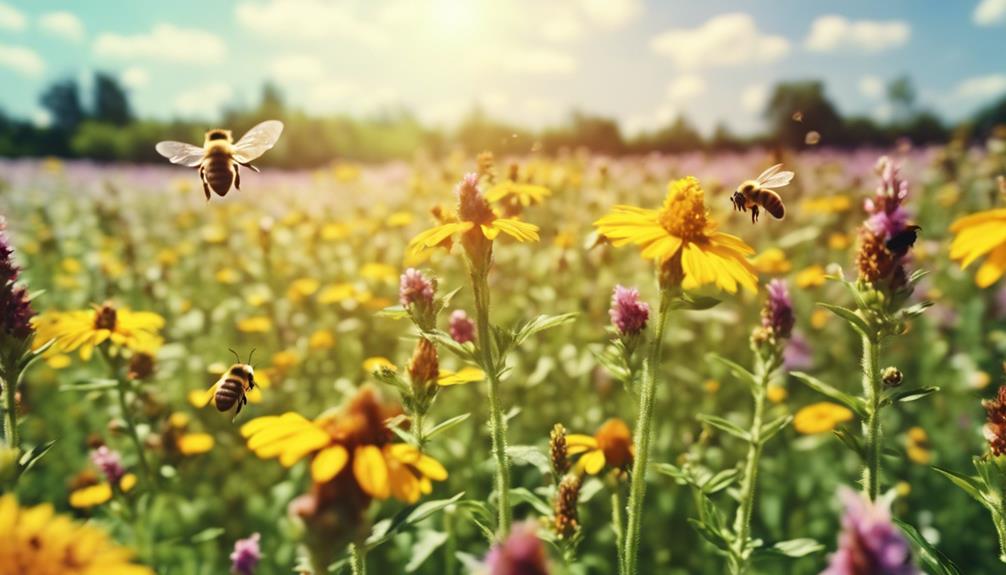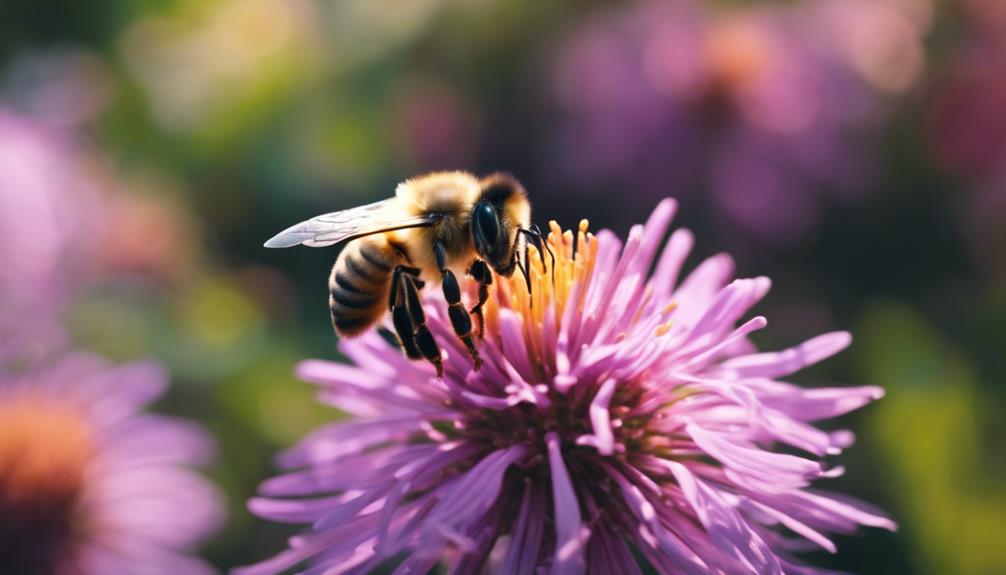August and September are pivotal times for harvesting honey as bees are at their busiest, stocking up their hives for winter. During this period, honey supers reach their peak, filled with deliciously cured honey ready to be extracted. It’s essential to maintain hive conditions for optimum flavor before the harvest. Keep in mind factors like hive productivity, nectar flow, and weather to guarantee a successful honey harvest. Remember, the bees work hard to make this liquid gold, so it’s vital to be mindful of the best moments for reaping the rewards.
Main Points
- August and September are optimal for honey harvesting due to peak production and well-cured honey.
- Consider hive productivity, nectar flow, and weather conditions for successful harvest timing.
- Inspect hives thoroughly before harvesting to ensure health, queen excluder placement, and winter reserves.
- Prepare bees for winter with supplemental feeding, hive monitoring, and insulation.
- Timing impacts honey quality and quantity; aim for late summer or early fall for best results.
Importance of Harvesting Honey in August and September
In August and September, we prioritize harvesting honey due to the peak production period and the bees’ filled honey supers. Late summer is the perfect time to collect honey as the bees have been hard at work ensuring their hives are stocked for the upcoming winter. Harvesting during this period guarantees that the bees have ample honey stored to sustain them through the colder months ahead.
The honey collected in late summer is usually well-cured and ready for extraction, providing us with high-quality, delicious honey to enjoy. Monitoring the hive conditions during August and September is vital in determining the best timing for the harvest, ensuring we gather the honey at its peak flavor and nutritional value.
Factors Influencing Harvesting Month for Honey
Considering hive productivity, nectar flow, and weather conditions, we determine the best month for harvesting honey. Nectar flow plays an important role as bees need ample supply to produce honey efficiently. High hive productivity indicates a strong colony capable of storing surplus honey for harvesting.
Additionally, favorable weather conditions are essential for bees to forage and dry honey effectively. Harvesting at the right time guarantees proper winter provisioning, reducing the risk of starvation and the need for supplemental feeding during the colder months.
Late harvests may lead to challenges like thick honey due to cold temperatures and increased robbing pressure. Therefore, a balanced approach considering these factors is key to successful honey harvesting and bee colony management.
Beehive Inspection Before Harvesting
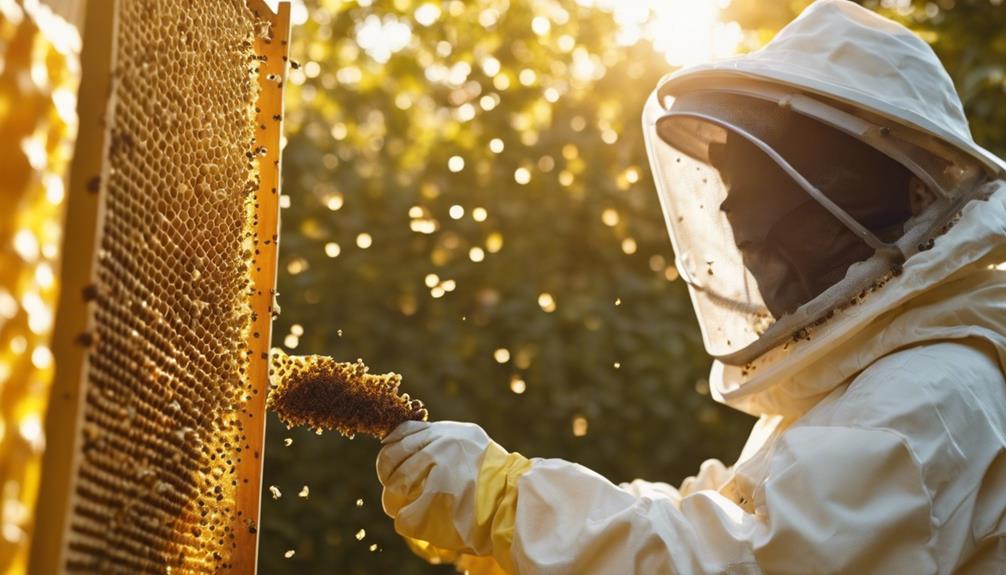
Before delving into the sweet harvest, we always begin with a comprehensive beehive inspection. Checking the hive’s health and honey reserves is vital for our buzzing friends.
From assessing the hive structure to searching for capped honey frames, these steps guarantee a successful and responsible honey extraction process.
Hive Health Check
Upon examining the beehive before gathering honey, we must carefully evaluate hive health for diseases, pests, and overall colony strength.
It’s vital to look for signs of queen activity, check on brood development, and assess honey reserves during the beehive inspection.
We need to determine if additional honey supers are necessary based on the hive’s population and honey storage. Don’t forget to confirm there’s a queen excluder in place to prevent larvae from ending up in the honey supers.
Before proceeding with the honey harvest, it’s important to verify that the bees have enough honey reserves for winter survival.
Taking these steps ensures a healthy hive and a successful honey harvest down the line.
Worker Bee Activity
When preparing to harvest honey, our focus shifts to monitoring worker bee activity through thorough beehive inspections. As we explore the hive, we observe the bustling colony meticulously. Our eyes search for frames of honey, making sure they’re capped and ready for harvest.
The diligent worker bee behavior reveals much about the colony’s readiness. Are they storing enough honey for themselves? Is the comb construction strong and healthy? These are the questions we seek to answer before extracting honey.
Honeycomb Inspection
Examining the honeycomb frames for capped cells is crucial before harvesting honey to guarantee ideal ripeness and quality. When inspecting the honeycomb, keep these key points in mind:
- At least 75% capped cells: Make sure that a significant portion of the honey cells is capped to indicate proper moisture content for storage.
- Uniform capping: Look for consistent capping across frames to ensure the honey is uniformly ripe.
- Avoid uncapped cells: Check for any uncapped cells, which may indicate unripe honey needing more time to mature.
Preparing Bees for Winter Months After Harvest
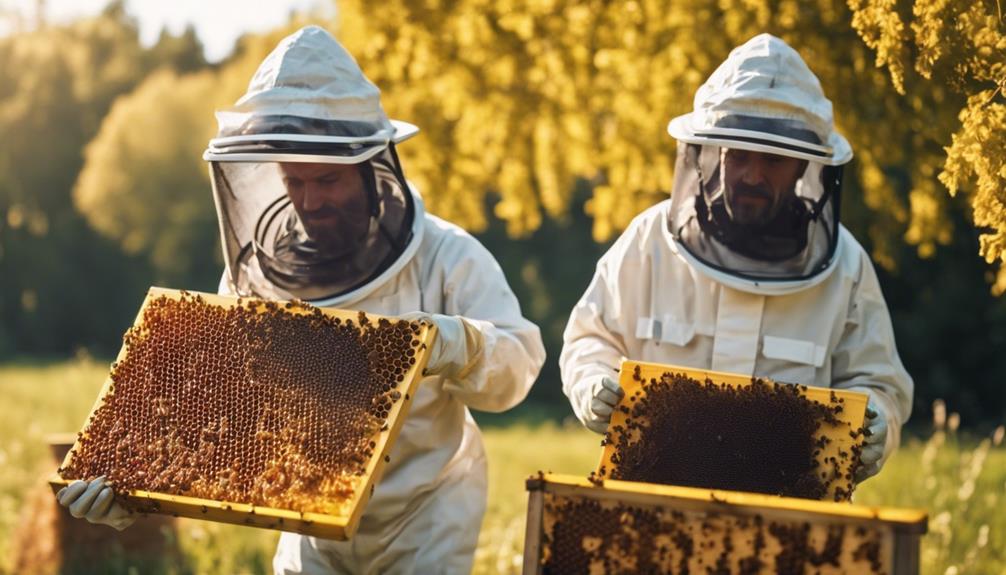
As we gear up for the winter months post-harvest, it’s imperative to winterize our bee colonies, provide them with supplemental feeding, and closely monitor hive health.
Ensuring our bees have enough honey reserves will reduce feeding demands during the colder season and promote the well-being of the colony.
Winterizing Bee Colonies
To safeguard the well-being of our bee colonies during the upcoming winter months, we must conscientiously prepare them through the process of winterization. Here are three essential steps to make sure our bees have enough honey to survive the colder season:
- Check Food Reserves: Before winter sets in, it’s important to assess the honey stores in the hives. Bees need enough food to sustain themselves through the winter when foraging becomes challenging.
- Insulate the Hives: Protecting the colonies from extreme cold is crucial. Insulating the hives can help maintain a stable temperature, ensuring the bees stay warm and healthy during the winter months.
- Monitor Hive Health: Regularly monitoring the hive’s health and food supplies is essential to identifying any issues promptly. This proactive approach can prevent problems and support the bees’ well-being throughout winter.
Providing Supplemental Feeding
After winterizing our bee colonies to guarantee their well-being during the colder season, we focus on providing supplemental feeding to prepare them for the winter months following the honey harvest. Supplemental feeding plays an important role in helping bees store enough honey to survive the winter months.
By offering sugar syrup, we give our colonies a boost in building up their food reserves post-harvest. It’s essential to monitor the hive’s food levels closely at this stage to prevent any risk of starvation during the winter.
Proper supplemental feeding not only supports the colony’s health but also secures their longevity beyond the honey harvesting season. Taking these steps helps us care for our bees and set them up for a successful winter ahead.
Monitoring Hive Health
We thoroughly assess the hive health post-harvest to guarantee our bees have sufficient honey reserves for enduring the winter months.
Key Points to Take Into Account:
- Check Honey Stores: Monitor the brood boxes to make sure there are enough honey stores to sustain the colony through the colder months.
- Inspect for Issues: Look out for any signs of disease or pest infestation that could impact the hive health after the honey harvest.
- Assess Colony Strength: Evaluate the overall strength and population of the colony to determine if they’re adequately prepared for winter.
Ensuring Sustainable Honey Harvesting Practices
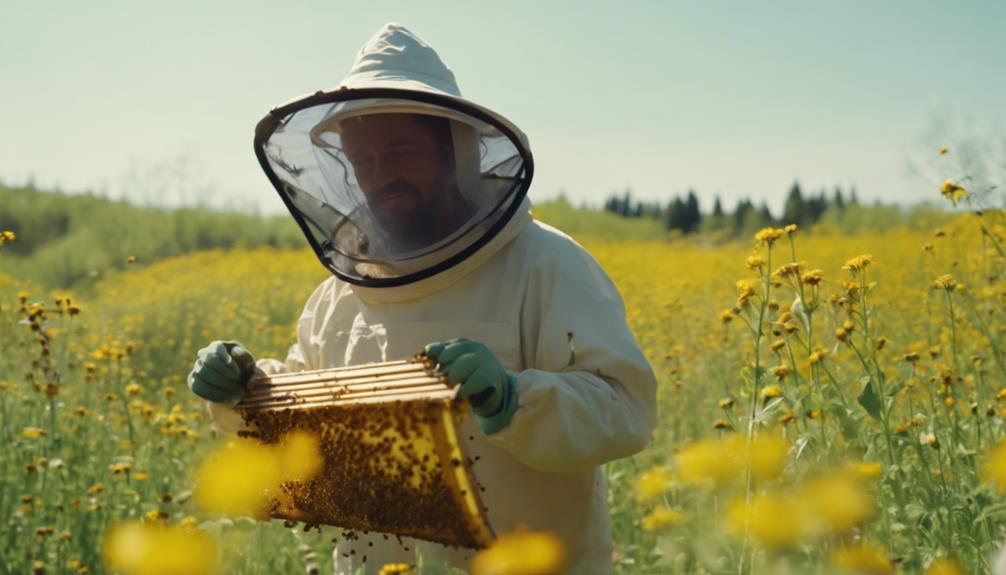
Monitoring hive health and honey reserves is vital for guaranteeing sustainable honey harvesting practices. By regularly checking the state of our honey bee colonies and the quantity of honey they’ve stored, we can make informed decisions during harvest time.
Evaluating the hive establishment and structure allows us to determine if additional honey supers are needed to support a sustainable honey production process. Using a queen excluder during extraction ensures that we obtain larvae-free honey, promoting the overall health of our bee populations.
It’s essential to confirm our bees have an ample honey supply for winter survival, prioritizing sustainability in our honey harvesting practices. These practices not only benefit the bees but also contribute to a more environmentally conscious and thriving beekeeping operation.
Tips for Successful Honey Harvesting
To achieve successful honey harvesting, it’s crucial to assess hive productivity and honey cell capping to determine the best time for extraction. Here are three essential tips for a fruitful harvest:
- Monitor Honey Supers: Check if there’s sufficient honey stored in the frames of the honey supers. Be certain the honey is fully capped and matured before harvesting to guarantee its quality.
- Consider Timing: Late summer or early fall is generally the optimal time for harvesting honey. Take into consideration hive conditions, nectar flow, and weather for a successful extraction.
- Leave Adequate Honey: Always leave enough honey frames for the bees to survive the winter. Prioritize their well-being by ensuring they’ve ample food reserves before taking the surplus.

Hello! My name is Noel Calvin. I graduated from UCLA and now work as a writer at Launch Ninjas. I write blog posts that inspire and guide our readers in their entrepreneurial pursuits. I live in Pleasantville, NJ, with a peaceful yet lively atmosphere that inspires me.
Writing stories is more than just a job for me. It allows me to share my observations and satisfy my curiosity about the world. I combine my analytical skills with creative enthusiasm to delve into technology trends and startup stories. But my life isn’t limited to screens and keyboards. I value loyalty, passion, and a touch of old-fashioned charm, which I infuse into every narrative I create.
I love spending time in my garage, jamming with my band when I’m not writing. Playing the guitar and singing bring me immense joy. I also enjoy capturing ordinary and extraordinary moments through my camera lens and exploring new culinary adventures that excite my taste buds. I’m always seeking new experiences.
My family is very important to me. Joyful Sunday brunches filled with laughter and intense board game nights keep me grounded, reminding me of life’s simple pleasures.
In my world, every moment is an opportunity for discovery. Every discovery is a story worth sharing, whether a heartfelt moment at home or the pulse of technological innovations. Join me as I navigate through life, one blog post, one guitar strum, and one heartwarming family dinner at a time.
